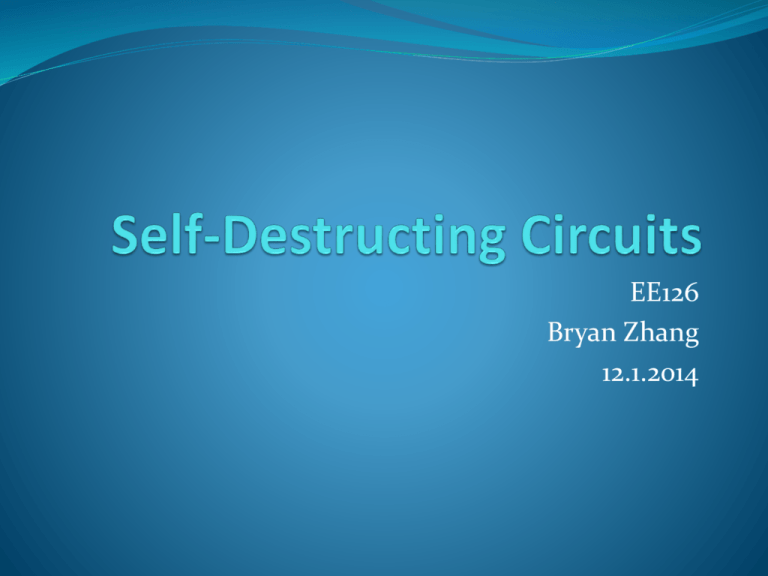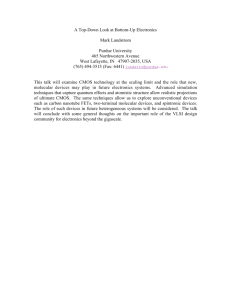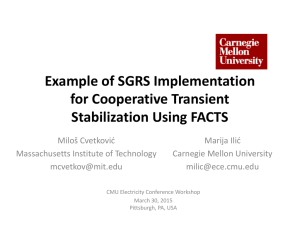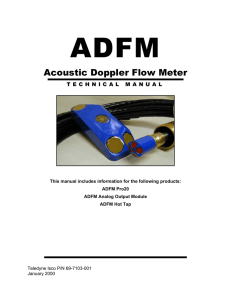Self-Destructing Circuits
advertisement

EE126 Bryan Zhang 12.1.2014 Background Circuits purposefully designed to destruct after a certain period Physically disappears Also known as “transient electronics” Materials of circuit must be selected according to specific environments i.e. Silicon’s properties suited for aqueous decomposition Importance Medical applications Transient Sensors, implants Environmental Impact Bio-degradable, vanishing sensors Military utility Surveillance equipment Precious technology Consumer electronics Methods Silk protein encapsulation (Tufts, U. Illinois, others) Sturdy Biodegradable Ultra-thin sheets of silicon + magnesium/magnesium oxide conductors and dielectrics Water-soluble Zinc oxide is alternative to silicon Insulating polymer films (Iowa State University) Biodegradable Man-made Current Issue: Timing the Destruction Big obstacle: achieving desired degradation time Different materials have various degradation speeds Silicon, nitride, and zinc oxide are two main choices due to hydrolysis Conductors: Low resistivities, stability, current existence in technologies Magnesium for electrodes (hydrolysis, biocompatibility) Zinc, Iron, Tungsten as alternatives Alloys are being researched for their mechanical properties Aluminum can slow degradation rate Iron hydroxides also decompose more slowly than elemental iron Timing the Destruction (continued) An alternative approach is to use biomaterials for encapsulation As opposed to metals Polyvinyl alcohol based (PVA) Combined with gelatin to slow degradation, sucrose to accelerate Future Developments Program the circuit or device to destruct Opposed to controlled degradation over time Have non-aqueous self-destruction Conclusions Nascent technology with large potential impact Next step for electrical development Sound investment to remain at the forefront of BME/EE research References AVS: Science & Technology of Materials, Interfaces, and Processing. (2014, October 9). Dissolvable silicon circuits and sensors. ScienceDaily. Retrieved November 29, 2014 from www.sciencedaily.com/releases/2014/10/141009153809.htm Hwang, S., Song, J., Huang, X., Cheng, H., Kang, S., Kim, B., ... Rogers, J. (2014). High Performance Biodegradable/Transient Electronics on Biodegradable Polymers. Advanced Materials, 26(23), 3905-3911. Retrieved December 1, 2014. Kang, S.-K., Hwang, S.-W., Cheng, H., Yu, S., Kim, B. H., Kim, J.-H., Huang, Y. and Rogers, J. A. (2014), Dissolution Behaviors and Applications of Silicon Oxides and Nitrides in Transient Electronics. Advanced Functional Materials, 24: 4427–4434. doi: 10.1002/adfm.201304293 Rogers, J. (2014, July). Inorganic Substrates and Encapsulation Layers for Transient Electronics. Retrieved November 29, 2014 from www.engineeringvillagecom. Thurler, K. (2012, September 27). Smooth as Silk "Transient Electronics" Dissolve in Body or Environment. Retrieved November 29, 2014, from http://now.tufts.edu/newsreleases/smooth-silk-transient-electronics Yin, L., Cheng, H., Mao, S., Haasch, R., Liu, Y., Xie, X., Hwang, S.-W., Jain, H., Kang, S.K., Su, Y., Li, R., Huang, Y. and Rogers, J. A. (2014), Dissolvable Metals for Transient Electronics. Advanced Functional Materials, 24: 645–658. doi: 10.1002/adfm.201301847









